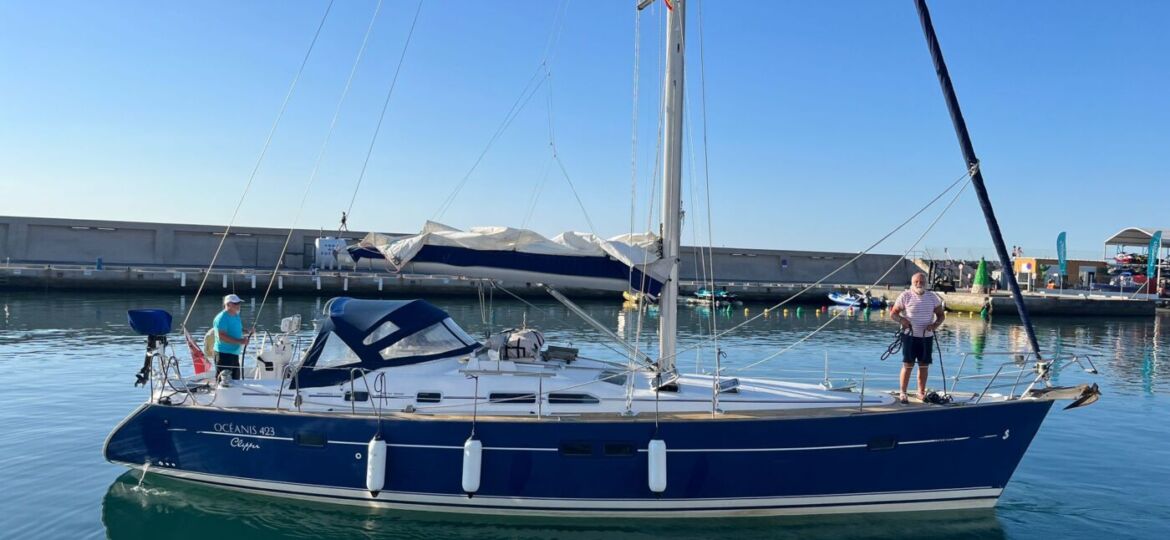
The chairman, together with a few crew (including some from the CBYA) successfully delivered his yacht Sapphire from Cowes, Isle of Wight, to Calpe Marina during June and July.
We left Shepherd’s Wharf on the 18th June from Cowes (right after the Round the Island event). After a brief supper of Fish n Chips in the Anchor pub in Cowes, we slipped our moorings at 2100 and made our way down on the strong spring ebb tide to Hurst Narrows and then through the channel between the Needles and the Shingles bank and then as night fell, into the English Channel. It’s always easier to navigate the lighthouses and buoys in the narrows at night.
The weather in the Channel was a brisk North Easterly F4-5 meaning we had to gybe many times to navigate the shipping lanes and reach Ushant, but it did mean that we kept up a respectable boat speed of between 8 and 9 knots, down to the Channel Islands (west of Guernsey) and then along the Brittany coast.
We rounded Ushant at about midnight on the second day and then sailed into Brest the next morning. The only issue during this part of the trip was that, when reefing in big seas, the log, which was not inserted correctly by a previous crew, popped out and flooded the boat. After re-seating it, we then had to pump the boat dry.
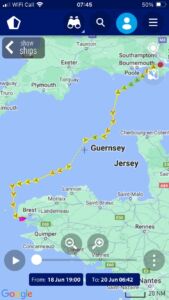
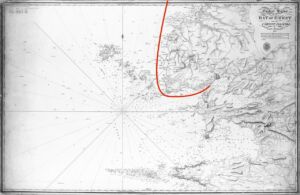

We stayed in Brest that day, dining on crab and oysters and plenty of local wine, and then decided to postpone leaving harbour the next day as a depression in the approaches was creating a 35kt SW gale of wind in Biscay. We therefore left Brest on the ebb tide of the 22nd June at 7am. We cleared the rocks in the approaches to Brest and punched our way through the Raz de Sein (as the flood had just started) and entered Biscay at about noon.


In Biscay, the wind was westerly F4-5 for a time, but then moderated and veered to the northeast on the second day. However a large NW swell had built up which made the boat role through 50 degrees occasionally. Biscay took 3 days to cross in all, mostly in benign weather (apart from a swell of around 4 meters). Occasionally the wind reached 25kts but moderated often. The weather was grey, rainy and cold the whole time. We completed the crossing in 2 1/2 days without incident.
By the morning of the 3rd day the wind had dropped completely and we motored the final 100 miles to Cape Finistaire. Large thundery clouds and occasional bright spells alternately bathed La Caruña in sunshine and then obscured it in heavy rain. We rounded the cape in a lively northwesterly F5 and sailed most of the way down the coast of Portugal, until suddenly we ran into thick fog!
In the fog the wind backed to southerly and we had to beat to windward into and out of bays and headlands for many hours until the wind eventually dropped off and then died completely, leaving us wallowing in amongst a crowd of fishing boats (only visible on AIS). There were lobster pots everywhere, looming out of the fog and passing along each side of the boat, keeping us constantly on our toes. As daylight was starting to fade and the wind had died away almost completely, we were forced to turn on the engine and motor sail. There was now only 30 miles to go to Porto. Disappointingly, after a couple of hours, the engine revs unexpectedly dropped off, then picked up again and then the motor stopped altogether! Luckily, according to the plotter, we were just outside a harbour called Póvoa, and with almost no wind other than a slight westerly breeze, we ghosted towards land until the harbour appeared in front of us. We entered the marina under sail and moored alongside against some very old and rickety pontoons.
As it turned out, the Póvoans were celebrating the Fiesta de San Pedro, so the town was alight with festivities (how lucky). Although we were all dog tired, we did managed to celebrate a little with a couple of beers (well 5 or 6 actually), and crashed into bed at about 02:30am
At 9am the next morning, I went to see a mechanic, but he told me he was so busy, he couldn’t look at our engine problem for at least 3-4 weeks! So we tried the engine again and it started and luckily, kept running all the way to Porto. In Porto, I stripped down the fuel system: pre-filter, main filter and fuel tank pickup. Everything was caked with thick black stringy diesel bacteria. I bought some diesel additive and poured it into the tank, changed all the filters and cleaned the pickup and pipes, then gave it 24 hours to work (which gave us another welcome night out). The next morning the engine started first time and ran OK on the mooring at 2000 rpm for about an hour, so we decided to leave without delay … the next morning. We had found some great restaurants in the village of Gaia, selling local sardines and wines so it would have been sacrilege to pass up that opportunity.
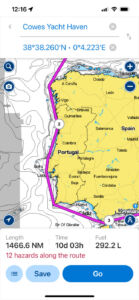

We left Porto in the morning, put some fresh fuel in cans we’d brought and motored south toward Lisbon. Almost immediately, the fog returned. It seems to be quite common in this location in June. Another long day of peering into the gloom to spot lobster pots, but once the depth was more than 100 meters, they were no longer an issue. Again the fog was accompanied by a southerly wind and once more we returned to beating down the coast. By midday the fog evaporated and the wind died, so we started motoring again. In fact we motored for another whole day, round Cape st Vincent and along the coast of the Algarve. Now heading south east in the bay of Cadiz, the wind came up, a lively southwesterly and we were were sailing “free and by” again at 8 to 9 knots. All day the wind increased, and we continued to reduce sail. First one reef in the main, then two, which with half headsail gave us a more comfortable run in the following ocean swell.
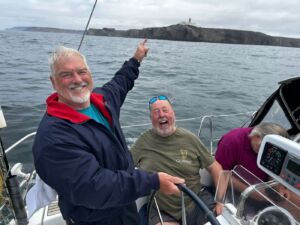

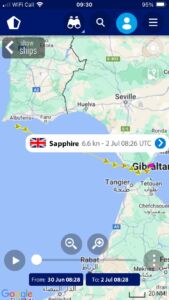

Sapphire ran downwind for two days towards Gib, hardly deviating and on the morning of the 3rd day, we took in the headsail and motor into the Bay of Barbante to play with the Orcas! In 20m depth we saw some very large bottle-nosed dolphins, but no other wildlife. I guess the whales weren’t in the mood to play. A mixed blessing perhaps or maybe a pity; I have seen Orcas many times, and never had any incidents. Here’s a photo I took on one of my earlier transatlantic passages (from my X-412 ‘Sans Culottes’) 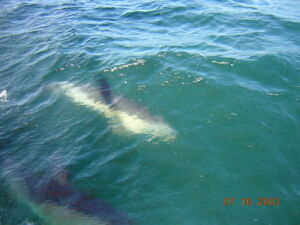

We reached Gib that afternoon in a full on southwesterly gale – 30 kts gusting 35. It was too windy to drop the main and with a lot of shipping coming in and out of the harbour, we ran on with just the double reefed main but no headsail, eventually dropping the main behind a large tanker, anchored just outside the main harbour wall. But like most harbours, as soon as we entered the marina, the wind dropped off to nothing. We oiled up, filling our main tank and then moored in front of the mock cruise liner/hotel in Ocean Village. What a lovely spot – friendly staff, great facilities and really cheap (the advantages of a tax-free haven). Ocean Village is full of bars and restaurants, so we had a great evening.
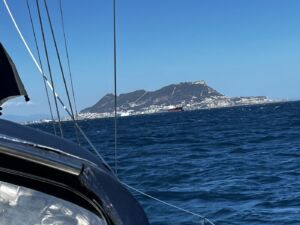

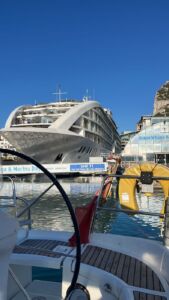

It was now time for two of the crew to leave for England, but decided that as there was more choice of flights from Malaga than Gibraltar, so we made for there. The next day we sailed out of Gib and along the coast of the Costa de Sol. We passed Marbella, Fuengirola and Benalmádena only to find that there is no marina in Malaga, only a private Club Nático (that wouldn’t let us land) and a super-yacht terminal, so we were forced to sail back to Benalmádena. This was some 8 miles back in the direction we had come, which is not far, but had to be done at night. Then … the engine died (again)!


We sailed into Benalmádena, mooring on the fuel pontoon. Two of our crew packed and ordered a taxi for Malaga but myself and Micky Cuthbert stayed overnight and sailed off the mooring the next morning to day sail the boat to Calpe. The engine seemed to be running again but spluttered and died off Motril, so we put in there … but on the way in, the engine picked up again. I was still convinced it was fuel related, so the next day we pushed on to Almaremar, where I knew there were good service facilities.
By the afternoon we were tied up in the inner harbour in Almerimar. The resident mechanic Paul Taylor was really helpful. He took the whole fuel system apart and diagnosed that the fuel lift pump was the cause of our problems, and Mike, from Alamar Náutico ordered us a replacement pump from Volvo. We watching England beat Holland in the Euros, and then went home to Moraira (Micky’s wife Brenda kindly making the 9 hour round trip to pick us up). The part arrived from Volvo in Almería on Wednesday the following week and Paul kindly replaced the pump, removed all the fuel, cleaned out the tank and changed the fuel lines.



As Micky had now gone home, Malcolm Reeve kindly offered to help me to bring Sapphire back to Calpe. We drove to Almerimar (in a hired car) to collected the yacht. Malcolm and myself were able to sail the yacht non-stop to Calpe, taking turns to keep watch. There wasn’t much wind for most of the trip, but this time, the engine didn’t miss a beat. Problem solved it seems. It was only when we got to Calpe at midday the next day that the wind came up – 25kts in Calpe Bay, but as ever, it was calm in the marina.
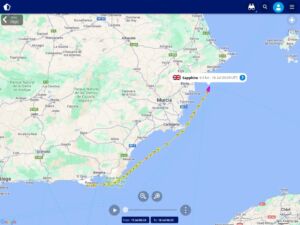

Sapphire is now on her permanent berth in Calpe. It was an odyssey to be sure, but fantastic fun and are looking forward to making many more trips in the Mediterranean over the coming years.
If you want to hear more about my trip, I will be at Bar Tropicana on Tuesday chiringuito evening. See you there hopefully.
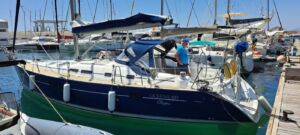



Fantastic and entertaining true life story enjoyed reading to my Peter over breakfast . We just spent a calm few days on his motor boat traveling upstream on the Thames very peaceful and easy by contrast lol
What a great adventure! Well done to all.
Wonderful description of a great sea sailing trip.
You were faced with critical choices due to engine failures, and overcame everything thrown at you.
Well done and we can see what a great sailing chairman the club has.
A great read and journey John. Well done – happy days!
You Coped well with engine problems, I found the best thing to do is every time you will leave the boat for a long time is to fill the tank full, before you do that put the correct amount of fuel medicine to prevent the bacteria forming. It works.